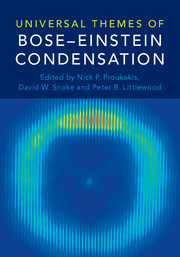Book contents
- Frontmatter
- Contents
- Foreword
- Preface
- Part I Introduction
- Part II General Topics
- Part III Condensates in Atomic Physics
- Editorial Notes
- 13 Probing and Controlling Strongly Correlated Quantum Many-Body Systems Using Ultracold Quantum Gases
- 14 Preparing and Probing Chern Bands with Cold Atoms
- 15 Bose-Einstein Condensates in Artificial Gauge Fields
- 16 Second Sound in Ultracold Atomic Gases
- 17 Quantum Turbulence in Atomic Bose-Einstein Condensates
- 18 Spinor-Dipolar Aspects of Bose-Einstein Condensation
- Part IV Condensates in Condensed Matter Physics
- Part V Condensates in Astrophysics and Cosmology
- Universal Bose-Einstein Condensation Workshop
- Contributors
- Index
- References
15 - Bose-Einstein Condensates in Artificial Gauge Fields
from Part III - Condensates in Atomic Physics
Published online by Cambridge University Press: 18 May 2017
- Frontmatter
- Contents
- Foreword
- Preface
- Part I Introduction
- Part II General Topics
- Part III Condensates in Atomic Physics
- Editorial Notes
- 13 Probing and Controlling Strongly Correlated Quantum Many-Body Systems Using Ultracold Quantum Gases
- 14 Preparing and Probing Chern Bands with Cold Atoms
- 15 Bose-Einstein Condensates in Artificial Gauge Fields
- 16 Second Sound in Ultracold Atomic Gases
- 17 Quantum Turbulence in Atomic Bose-Einstein Condensates
- 18 Spinor-Dipolar Aspects of Bose-Einstein Condensation
- Part IV Condensates in Condensed Matter Physics
- Part V Condensates in Astrophysics and Cosmology
- Universal Bose-Einstein Condensation Workshop
- Contributors
- Index
- References
Summary
Quantum mechanically, static or applied gauge fields manifest themselves by directly coupling to a system's phase. Artificial gauge field techniques manipulate the phase of a Bose-Einstein condensate's order parameter, yielding effects present in condensed matter systems subject to magnetic fields, electric fields, or spin-orbit coupling. In this chapter, we explore the impact of these artificial gauge fields on Bose- Einstein condensates and explain the consequences. Several analogues to traditional condensed matter systems are enabled by these techniques, including the Hall effect, superfluid vortex nucleation in systems with artificial magnetic fields, and magnetic-like phase transitions in systems with spin-orbit coupling.
Introduction
Since the first experiments with Bose-Einstein condensates (BECs), researchers have exploited the universality of physical laws to draw analogies between the behavior of ultracold quantum gases and systems ranging from material to astrophysical. These analogous situations are deliberately engineered, giving cold-atom “quantum simulators” [1] that exhibit behavior either observed or predicted in analogous quantum systems.
Superfluidity was one of the first many-body quantum phenomena demonstrated in BECs. For example, several experiments showed superfluid behavior by rapidly rotating the condensates and observing the formation of vortices [2, 3, 4, 5] – quantized point-defects in the BEC's order parameter. In the rotating frame of these experiments, this nucleation of vortices could be understood as the consequence of an artificial magnetic field [6] that arises via the formal equivalence of the rotating-frame Coriolis force and the Lorentz force, which we describe in Section 15.4.1. Together with other measurements, these results proved to be in excellent agreement with the predictions of the Gross-Pitaevskii equation (GPE) [7], a decades-old idealization of superfluid helium.
Buoyed by the prospect for studying magnetic field–driven strongly correlated systems using these nearly ideal quantum gases, proposals for alternate techniques to simulate gauge fields were developed. These methods primarily employ an internal state–selective atom–light coupling, where the photon momentum provides the forces necessary to mimic a Lorentz force [8, 9, 10, 11, 12, 13, 14, 15, 16]. The first demonstration of this type of technique used a spatially dependent Ramantransition scheme to effect a magnetic field [17], and experiments demonstrating artificial electric fields [18] and spin-orbit coupling [19, 20, 21, 22, 23, 24] soon followed.
- Type
- Chapter
- Information
- Universal Themes of Bose-Einstein Condensation , pp. 299 - 321Publisher: Cambridge University PressPrint publication year: 2017
References
- 1
- Cited by

